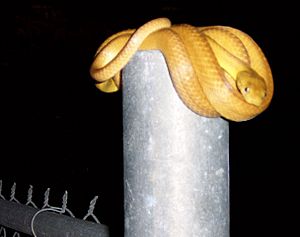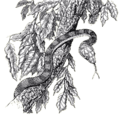Brown tree snake facts for kids
Quick facts for kids Brown tree snake |
|
|---|---|
| Scientific classification | |
| Kingdom: | |
| Phylum: | |
| Class: | |
| Order: | |
| Suborder: | |
| Family: | |
| Genus: | |
| Species: |
B. irregularis
|
| Binomial name | |
| Boiga irregularis (Merrem, 1802)
|
|
The Brown tree snake (Boiga irregularis) is a tree-dwelling snake found in parts of coastal Australia, Papua New Guinea, and islands in northwestern Melanesia.
This snake is well-known for being an invasive species. This means it has spread to new places where it doesn't naturally belong. It has caused big problems, especially on the island of Guam, where it has sadly killed many birds.
Contents
What Do They Eat?
The Brown tree snake enjoys eating birds, lizards, and bats. In its natural home, it also eats small rodents. When these snakes spread to places like Guam, they also eat birds and shrews.
Because there are so many animals to eat and not many animals that hunt them in places like Guam, these snakes can grow very large. They usually grow to be about 1 to 2 meters long. However, the longest one ever found on Guam was three meters long!
How Do They Reproduce?
Scientists haven't studied the reproduction of the Brown tree snake in great detail yet. The female snake lays between 4 and 12 eggs. These eggs are about 42–47 mm long and 18–22 mm wide. They have a leathery shell.
Female snakes can lay up to two groups of eggs, called clutches, each year. This depends on the season, the weather, and how much food is available. The female snake carefully places her eggs in safe spots. These can be hollow logs, cracks in rocks, or other places where they are protected from drying out and from very high temperatures.
Is Their Venom Dangerous?
The Brown tree snake is a snake that is active at night. It can be quite aggressive if it feels threatened. Its fangs are grooved, not hollow like some other venomous snakes. This means it's hard for the snake to inject a lot of poison into a human bite. So, usually, only a small amount of venom is given.
The venom seems to be a weak neurotoxic (affecting nerves) and possibly cytotoxic (damaging cells). Adult humans are usually not affected much by a bite. However, young children are in greater danger from the venom.
Images for kids
-
Invasive species on Guam
-
Biodegradable aerial bait cartridges consisting each of a dead mouse and 80 mg acetaminophen tablets, designed to catch on trees in areas where brown tree snakes are invasive
See also
 In Spanish: Culebra arbórea café para niños
In Spanish: Culebra arbórea café para niños







